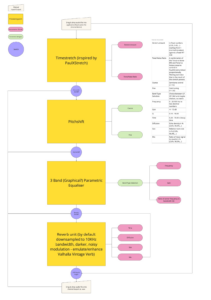What happened so far?
To know where to start modifying the Max phase vocoder, I drew comparisons between the same stretch factors in PaulXStretch and the phase vocoder. To keep the conditions as similar as possible, I changed the FFT size in PaulXStretch to 1024 and turned off all of the other parameters in the processing chain (harmonics, tonal vs. noise, frequency shift, pitch shift, ratios, spread, filter, free filter and compressor), with the expectation that the resulting sounds would just stretch the source sound (a ten second snippet from an acoustic multitrack recording) using the respective stretching algorithm. This would then allow me to hear differences.
When comparing the results, it quickly became evident that while the phase vocoder provided very transparent sounding stretches at lower stretch factors, the aesthetic quality of the Paulstretch algorithm and the smearing it introduces were a) very different sounding and b) more usable for the intended sound design purposes, where especially stretch factors over 10 become interesting and the original sound source becomes almost unrecognisable.

Note: I have now switched to working with the default phase vocoder that comes with Max as a resource example (Max 8 > Show package contents > Resources > Examples > fft-fun > phase-vocoder-example-folder). It has a lot of similar components.

Ongoing
Currently I am in the process of settling on EQ, reverb and pitch shifting modules to use for the prototype. Another more research-based aspect of the project is to figure out how the provided Python code from the old Paulstretch algorithm works, which will hopefully allow me to modify the phase vocoder towards a direction that suits the imagined aesthetic outcomes of ontextC. My supervisors are kindly is helping me with this, since I am not familiar with Python at all.
Results and Reflection
The results of the comparison are useful, because they define the differences that need to be overcome in order to reach the aesthetic results I am looking for with this plug-in. While some of the inner workings of the Paulstretch algorithm still remain unknown as of now, the Python code will hopefully help to figure out what is missing. Furthermore, being able to set the FFT size over 2048 to a value closer to a value along 4400 would be a next step to imitate the workflow that started this project better – the steps that follow will show whether that is a limitation in Max or not.
As a sidenote: The shortcuts CMD + Option + M to open a locked Max patch and CMD + 8 to remove the frame have been proven very helpful.
Objectives for Next Time
- Prep draft of sound example through all parts of the signal chain -> How does it start, which sound do we want to get to?
- Check out Phase vocoder template, start to modify parameters in project draft and experiment
- Settle on other modules in the processing chain
Keep in Mind: Mapping parameters together will become relevant sooner rather than later – it makes sense to research this as well.


